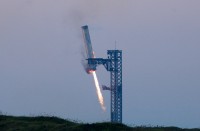A British entrepreneur has designed what he calls ‘the safest bike in history’ and hopes its manufacture could help those currently reluctant to cycle, due to safety concerns, to get in the saddle.
Crispin Sinclair and his team have created the Babel Bike, which they are seeking to fund via crowd-sourcing website Indigoego. According to Sinclair, the Babel’s protective cage positioned around the rider, combined with a double seat-belt and host of other safety features make it very safe.
“The main feature is the safety cage with the seat-belt, and the idea is that it’s wide enough that it won’t go under the side of a lorry, of a modern bus or lorry, so it gets pushed away instead, and also if you’re hit by a car it’s effectively the same as a car roll cage. It’s also got on the final version wing mirrors, indicators, hazard flashers, and a loud horn,” said Sinclair.
In large cities like London one of the biggest dangers for cyclists is being struck by a lorry, often without the lorry driver even being aware that a collision has occurred. This is usually because the cyclist has appeared in his so-called ‘blind spot’. In addition to the protective cage stopping the cyclist from being crushed against railings or another vehicle, the Babel’s automatic horn – as loud as a car horn – alerts a lorry driver to the accident.
“As soon as it’s hit it triggers the alarm which sounds like a loud car horn and that immediately tells the lorry driver that he’s got somebody in the blind spot,” explained Sinclair. “One of the big problems at the moment is that even when you’ve been hit often the driver doesn’t know and they just carry on down the road.”
Sinclair’s assistant Esteban Diaz conducted a series of tests in which a dummy strapped into the Babel was struck in a series of staged collisions by a 38-tonne goods vehicle. “We hired a lorry and we placed the prototype. We made the lorry turn and we saw how it reacts with the safety frame, so the safety frame was made of aluminum, aluminum tubing, and it turns out that it never gets underneath the lorry. It always gets pushed away and even dragged away it never puts the rider in a dangerous position, which is close to the wheels,” said Diaz.
Additional safety features include steel foot protectors, automatically-activated head and tail lights, plus hazard and brake lights.
The inventor isn’t the first Sinclair to have tried his hand at designing vehicle. His father Sir Clive Sinclair, who became famous for launching the Sinclair ZX range of home computers in the early 1980s, launched the Sinclair C5 electric vehicle in 1985, but it failed to impress consumers. A small open-topped vehicle made of polypropylene, potential buyers felt exposed to both inclement weather and heavy traffic. Seven years later he launched the lightweight electric bicycle Zike, which also flopped, despite seemingly being ahead of its time.
Sinclair says his father hasn’t been involved in the Babel’s development, but admits that growing up with an inventor has inevitably influenced him. “My father Clive Sinclair is obviously famous for his computers in the early days and obviously the C5 back in the 80s,” he said. “This particular project has kind of been my own, but I guess growing up with someone who makes and invents products and takes it all the way through to production I guess that’s inevitably an influence on the way I’ve done the business.”
The Babel bike will be manufactured in both pedal-electric and fully human-powered models. It includes a handlebar smartphone mount, and a security package that includes a Kryptonite U-lock. The pedal-electric model includes a 250-watt Shimano STEPS motor, powered by a removable 36-volt 11.6-Ah lithium-ion battery. A full four-hour charge will allow riders to travel between 50 and 80 miles (80-129 kilometers). It has a top electric-assist speed of 20 mph (32 km/h).
A pledge of £2,999 ($4,430 USD) will buy an electric model, while £1,999 ($2,950 USD) will secure a non-electric version. The bikes will subsequently be around 25 percent more expensive once the initial buyers have received their vehicles. (Reuters)








